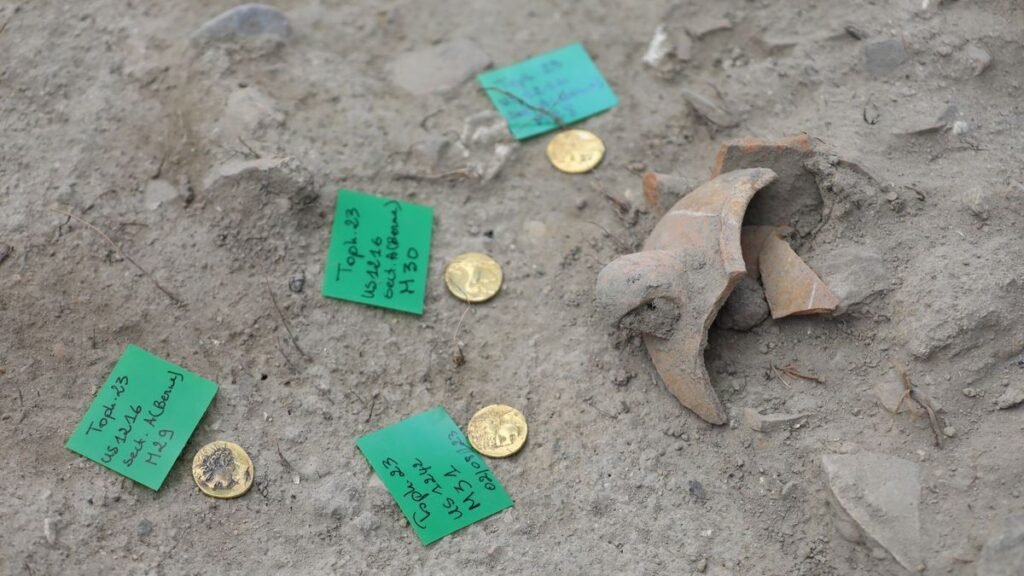Archaeologists have made a groundbreaking discovery at an ancient Carthaginian temple, unearthing a trove of rare gold coins depicting the goddess Tanit. These remarkable artifacts shed new light on the religious practices and cultural significance of the Carthaginian civilization. The find has excited historians and archaeology enthusiasts alike, providing valuable insights into a fascinating era of ancient history.
Archeologists in Tunisia have excavated rare, 2,300-year-old gold coins and urns holding the remains of animals, infants and premature babies from the ancient city of Carthage.

Ancient Carthaginian Temple Unveils Hidden Treasures
In a remarkable excavation project, archaeologists have uncovered a wealth of historical treasures at an ancient Carthaginian temple. Situated in modern-day Tunisia, the temple has revealed a remarkable glimpse into the religious practices and belief systems of the Carthaginian civilization. As the excavation progresses, researchers have unearthed a variety of artifacts, including statues, pottery, and jewelry, that provide valuable insights into the rich cultural heritage of this ancient civilization. The discovery of the temple goes beyond its physical structure, shedding light on the religious and social practices of the Carthaginians.
Rare Gold Coins with Goddess Tanit Resurface
One of the most significant findings in the excavation of the Carthaginian temple is the unearthing of a collection of rare gold coins. These coins, dating back to the 5th and 4th centuries BCE, depict the goddess Tanit, a prominent figure in the Carthaginian pantheon. Tanit was venerated as the goddess of fertility, war, and the moon, making her a central figure in Carthaginian religious life. The coins feature intricate designs and inscriptions, offering valuable insights into the artistic and cultural expression of the time. This discovery provides a unique opportunity to understand the economic and religious significance of these coins, as well as their role in the worship of Tanit.
The archaeological discovery of the Carthaginian temple and the rare gold coins depicting the goddess Tanit have opened up new avenues of research and understanding for historians and archaeologists. These findings not only shed light on the ancient Carthaginian civilization but also provide a unique glimpse into their religious beliefs and practices. As further research and analysis unfold, it is hoped that these discoveries will deepen our knowledge of this fascinating civilization and its contributions to ancient history.
Burial Discoveries and Rare Gold Coins Shed Light on Carthage’s Rich Cultural History ===
Carthage, the ancient city located in modern-day Tunisia, continues to reveal its rich cultural history through ongoing archaeological excavations. Recent burial discoveries in Carthage have provided fascinating insights into the funerary practices and beliefs of its inhabitants. In addition, the uncovering of rare gold coins has provided further evidence of Carthage’s economic prosperity and trade connections with other civilizations. These significant findings shed light on the vibrant and diverse society that once thrived in this ancient city.
Burial Discoveries Unearthed in Carthage
The burial discoveries made in Carthage have been a remarkable breakthrough for archaeologists. Excavations conducted in recent years have unearthed numerous tombs and burial sites, offering valuable information about Carthaginian funeral practices and their beliefs about the afterlife. Intricate burial chambers have been found, containing well-preserved artifacts such as pottery, jewelry, and even human remains. These findings have enabled researchers to gain a deeper understanding of the rituals, social hierarchies, and cultural traditions that were prevalent in Carthage.
One significant burial discovery in Carthage included a tomb believed to be that of a high-ranking Carthaginian noble. Decorated with beautifully painted frescoes depicting scenes from daily life and religious ceremonies, this tomb served as a testament to the artistic and aesthetic sensibilities of the Carthaginians. The presence of various grave goods, such as finely crafted jewelry and luxury items, hinted at the wealth and status of the deceased. These burial discoveries provide crucial insights into the social structures and customs that prevailed in Carthage during its heyday.
Unveiling Carthage’s Cultural History through Rare Gold Coins
In addition to the burial discoveries, rare gold coins that have been found in Carthage also contribute to the understanding of its cultural history. Carthage was known for its extensive trade networks, and the discovery of these coins attests to its thriving economy during ancient times. The coins, minted with intricate designs and inscriptions, offer glimpses into the artistry and craftsmanship of Carthaginian coinage. Furthermore, the presence of foreign coins among the discoveries suggests the city’s active engagement in international trade, revealing its connections with neighboring regions and distant civilizations.
One remarkable find was a collection of gold coins from the Hellenistic period, depicting various Greek gods and goddesses. These coins provide evidence of the cultural interchange between Carthage and the Greek colonies in Sicily and Magna Graecia. The presence of such coins in Carthage indicates the influence of Greek culture and highlights the cosmopolitan nature of the city. These rare gold coins not only serve as historical artifacts but also serve as a testament to Carthage’s position as a prominent trading hub and its ability to assimilate diverse cultural influences.
Carthage’s Rich Cultural History Unveiled
The ongoing excavations in Carthage continue to unearth significant discoveries that shed light on its rich cultural history. The burial discoveries provide valuable insights into Carthaginian funerary practices and societal structures, while the rare gold coins highlight the city’s economic prosperity and trade connections. These findings not only paint a vivid picture of Carthage’s past but also emphasize its position as a cosmopolitan and culturally diverse center in the ancient world. As archaeologists delve deeper into Carthage’s history, we can anticipate even more remarkable discoveries that will further enrich our understanding of this fascinating civilization.
